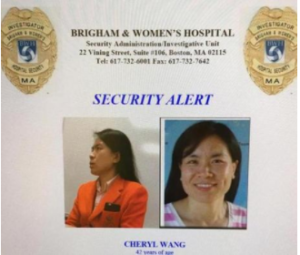Another Cautionary Tale on “Tailgaiting”: Brigham and Women’s Interloper Evades Hospital Security
How many times have you had your ID out and ready to swipe when someone ‘tailgates’ behind you, rounding a corner and asking you to hold the door for them?
What once was considered an act of courtesy, holding the door for a colleague, has increasingly been recognized as a frightening security gap in academic care centers. Last week, The Boston Globe broke news that Cheryl Wang, a former resident at Mount Sinai’s St Luke’s Hospital in New York, had tailgated her way into Brigham and Women’s operating suite and rounded with staff for several weeks before being apprehended while attempting to break into patient care areas in Children’s Hospital in Boston.

Cheryl Wang BOLO Warning issued by Brigham and Women’s Hospital
Wang certainly isn’t the first person to slide thru academic security, but she was surprisingly adept at getting a physician’s clearance and provided fake letters of recommendation. In September, Wang was able to get two days of operating room access shadowing a surgeon. The Globe reported that Wang had been dismissed from the St. Luke’s residency program for being argumentative and refusing to go into counseling.
After a thorough review of OR videos, Brigham and Women’s claims Wang never had directly interacted with patients or altered their care, but she certainly had access to patient information and came frighteningly close to what are considered to be some of the most secure areas of the hospital. Even when recognized as an uncredentialed interloper and confronted by Brigham and Women’s security, Wang wasn’t arrested. This is particularly surprising that just two years ago a patient’s son shot and killed star cardiovascular surgeon Michael Davidson outside his office at the same hospital.

Michael Davidson was killed by a patient at Brigham and Women’s Hospital in January of 2015
Other horrific security lapses in 2016 resulted in a physician being beaten to death in a hospitals by patients in Dallas and and another being fatally shot in a New Orleans regional hospital. Each of these cases was met with increased training for staff on active shooter situations, but eyes are on both the Joint Commission and Brigham and Women’s Hospital to see how they increase safety to avoid these situations in the future.
See The Joint Commission Guide for Violence and Active Shooter protocols here.






0 Comments